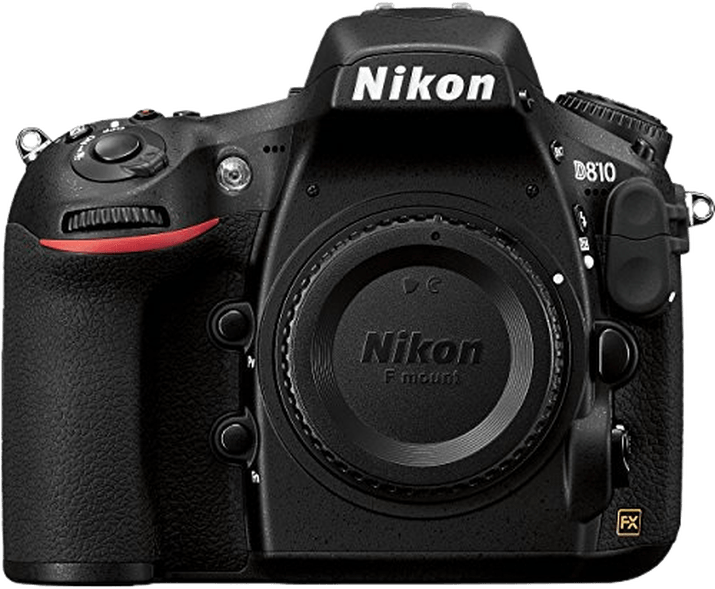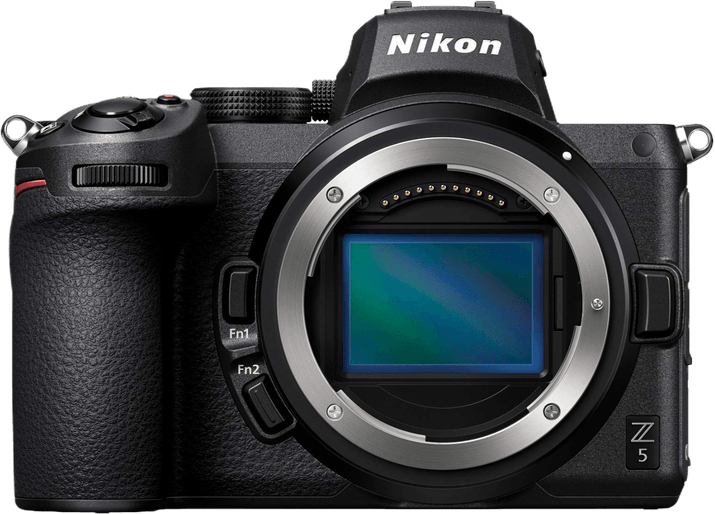Nikon D810 vs Z5 Comparison
Nikon D810

Nikon Z5

The Nikon Z5 outperforms the Nikon D810 with a score of 78/100 compared to the D810’s 72/100. Both cameras, the DSLR D810 and the mirrorless Z5, were introduced in 2014 and 2020, respectively. They share common specifications like the camera type and announcement dates. The Z5 excels with its lower launch price of $1400, smaller size (134 x 100.5 x 69.5mm), and lighter weight (675g / 1.49lbs). The D810, however, has a higher launch price of $3300 and is bulkier, measuring 146 x 123 x 82mm and weighing 980g / 2.16lbs. This comparison shows that the Nikon Z5 offers better value and portability, while the D810 may cater to users who prefer a larger and heavier camera.
Nikon D810 vs Z5 Overview and Optics
The Nikon Z5 outperforms the Nikon D810 in optics with a score of 81/100, compared to the D810’s 76/100. Both cameras share several specifications, including a CMOS sensor, a full-frame sensor size, and a DXOMARK score of 97 for the sensor. However, there are differences that contribute to the Z5’s higher score.
The Nikon Z5 has the advantage of an Expeed 6 processor, which is more advanced than the D810’s Expeed 4 processor. This improvement allows for better image processing and overall performance. Additionally, the Z5 features in-body image stabilisation, providing steadier shots and reducing the need for a tripod in certain situations. Another noteworthy distinction is the Z5’s Nikon Z lens mount, which accommodates a new generation of lenses designed for optimal performance with Nikon’s mirrorless cameras.
On the other hand, the Nikon D810 has a higher megapixel count of 36.3, compared to the Z5’s 24 megapixels. This enables the D810 to capture images with more detail and resolution, which may be essential for photographers who require large, high-quality prints. Furthermore, the D810 has a slightly faster shooting speed of 5 frames per second, whereas the Z5 shoots at 4.5 frames per second. This difference may be beneficial for capturing fast-moving subjects or action photography.
Despite the D810’s advantages in resolution and shooting speed, the Nikon Z5’s overall optics score is higher due to its advanced processor, in-body image stabilisation, and new lens mount system. While both cameras have their strengths and weaknesses, the Z5 is the more modern and technologically advanced option, making it the winner in this comparison.
Nikon D810 vs Z5 Video Performance
The Nikon Z5 outperforms the Nikon D810 in video capabilities with a score of 83/100 compared to the D810’s score of 70/100. Both cameras share some common specifications, such as a maximum video frame rate of 60fps and built-in time-lapse functionality. However, the Z5 offers superior video quality and resolution, making it the better choice for videography enthusiasts.
The most significant advantage of the Nikon Z5 is its 4K video resolution, providing a maximum video dimension of 3840 x 2160. This feature allows the Z5 to capture crisper and more detailed footage compared to the Nikon D810, which only offers Full HD resolution with a maximum video dimension of 1920 x 1080. The higher resolution of the Z5 is ideal for professional videographers or those looking to create high-quality content.
The Nikon D810, while not as advanced in video capabilities as the Z5, still has some benefits. Its Full HD resolution is sufficient for casual videographers and those who do not require the extra detail provided by 4K resolution. Additionally, the D810’s video frame rate of 60fps and built-in time-lapse functionality can still produce smooth and visually appealing footage.
Comparing the video capabilities of the Nikon D810 and Nikon Z5, it is evident that the Z5 is the superior choice for those prioritizing video quality and resolution. The Z5’s 4K resolution allows for more detailed and professional-grade footage, while the D810’s Full HD resolution is adequate for casual users. Both cameras offer a 60fps video frame rate and time-lapse functionality, making them capable of producing visually appealing and smooth footage.
Nikon D810 vs Z5 Features and Benefits
The Nikon Z5 outperforms the Nikon D810 in terms of features, scoring 72/100 compared to the D810’s 59/100. Both cameras share some specifications, including a 3.2-inch screen size and Wi-Fi connectivity. However, the Z5 surpasses the D810 in other aspects, making it the better option for certain users.
The Z5’s superior features include a touchscreen, a flip screen, and Bluetooth connectivity. The touchscreen allows for more intuitive control and easier adjustments to settings. The flip screen provides flexibility for shooting at different angles and is especially useful for vlogging or capturing images from challenging perspectives. Bluetooth connectivity enables seamless pairing with smartphones and other devices for instant photo sharing and remote camera control.
The D810, though lagging behind in features, offers a higher screen resolution of 1,229,000 dots compared to the Z5’s 1,040,000 dots. This difference provides a sharper and more detailed display, which can be advantageous for photographers who prioritize image review accuracy on the camera’s screen.
Despite the D810’s higher screen resolution, the Z5’s additional features make it the more versatile and user-friendly choice. The touchscreen, flip screen, and Bluetooth connectivity provide added convenience and functionality, catering to a wider range of users and photography styles. Conversely, the D810 may appeal to those who prioritize screen resolution and are willing to forego the additional features offered by the Z5. Ultimately, the choice between these two cameras depends on the individual’s needs and preferences in terms of features and functionality.
Nikon D810 vs Z5 Storage and Battery
The Nikon D810 triumphs over the Nikon Z5 in storage and battery with a score of 79/100, compared to the Z5’s 73/100. Both cameras share common specifications, such as two memory card slots and compatibility with SD, SDHC, and SDXC memory cards.
The D810 outshines the Z5 in battery life, offering 1200 shots with its EN-EL15 battery, while the Z5 only provides 470 shots using the EN-EL15c battery. This difference makes the D810 more reliable for extended shooting sessions without needing frequent battery replacements.
On the other hand, the Z5 has the advantage of USB charging, making it convenient for on-the-go charging. Additionally, the Z5’s memory card slots are UHS-II compatible, providing faster read and write speeds for high-resolution files.
Considering these points, the Nikon D810 is the better choice for those prioritizing battery life and reliability. However, the Nikon Z5 offers advantages in charging convenience and faster memory card performance.
Nikon D810 vs Z5 – Our Verdict
Are you still undecided about which camera is right for you? Have a look at these popular comparisons that feature the Nikon D810 or the Nikon Z5:

